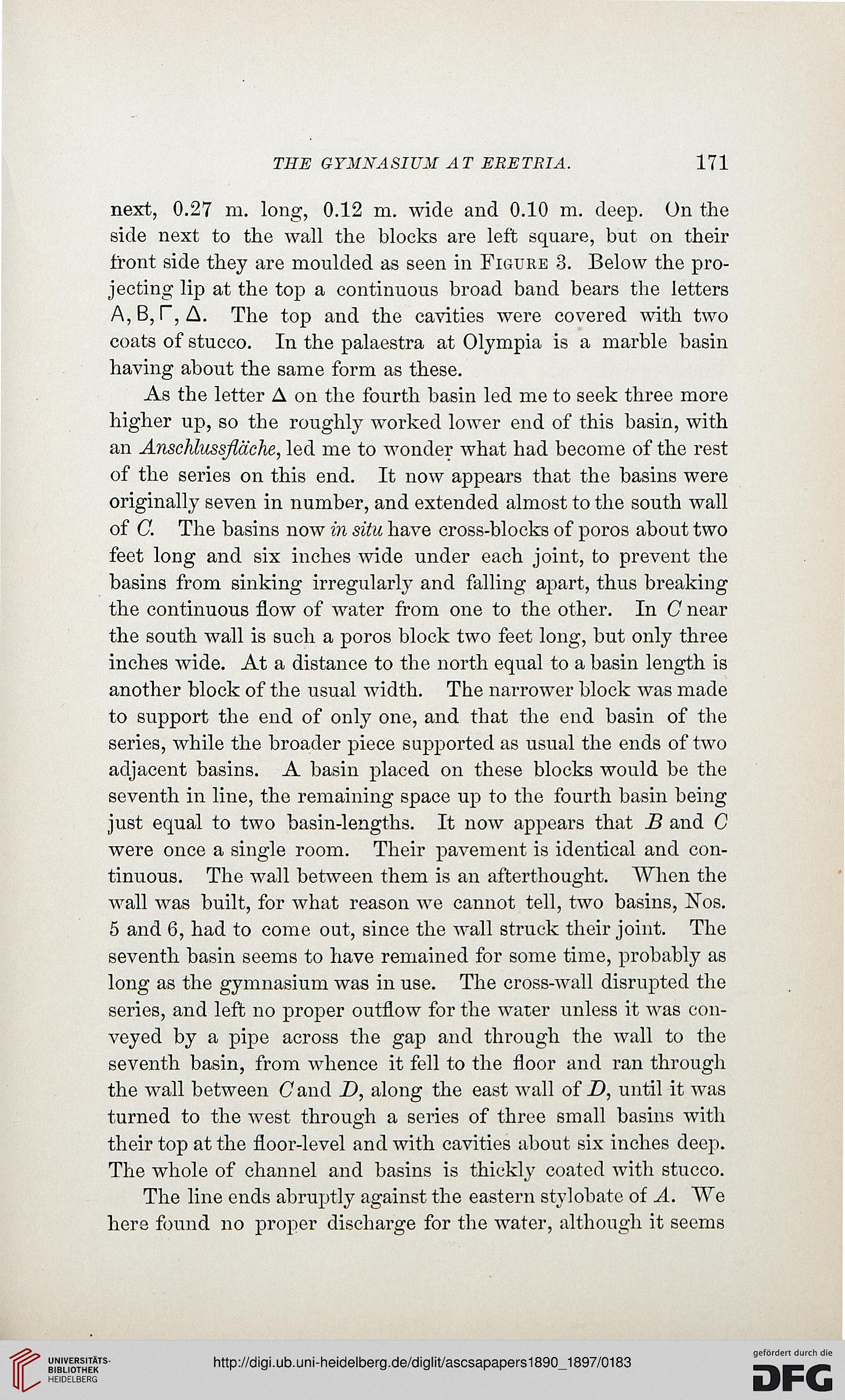THE GYMNASIUM AT ERETEIA.
171
next, 0.27 m. long, 0.12 m. wide and 0.10 m. deep. On the
side next to the wall the blocks are left square, but on their
front side they are moulded as seen in Figure 3. Below the pro-
jecting lip at the top a continuous broad band bears the letters
A,B,T, A. The top and the cavities were covered with two
coats of stucco. In the palaestra at Olympia is a marble basin
having about the same form as these.
As the letter A on the fourth basin led me to seek three more
higher up, so the roughly worked lower end of this basin, with
an Anschlussflache, led me to wonder what had become of the rest
of the series on this end. It now appears that the basins were
originally seven in number, and extended almost to the south wall
of C. The basins now in situ have cross-blocks of poros about two
feet long and six inches wide under each joint, to prevent the
basins from sinking irregularly and falling apart, thus breaking
the continuous flow of water from one to the other. In G near
the south wall is such a poros block two feet long, but only three
inches wide. At a distance to the north equal to a basin length is
another block of the usual width. The narrower block was made
to support the end of only one, and that the end basin of the
series, while the broader piece supported as usual the ends of two
adjacent basins. A basin placed on these blocks would be the
seventh in line, the remaining space up to the fourth basin being
just equal to two basin-lengths. It now appears that B and C
were once a single room. Their pavement is identical and con-
tinuous. The wall between them is an afterthought. When the
wall was built, for what reason we cannot tell, two basins, Nos.
5 and 6, had to come out, since the wall struck their joint. The
seventh basin seems to have remained for some time, probably as
long as the gymnasium was in use. The cross-wall disrupted the
series, and left no proper outflow for the water unless it was con-
veyed by a pipe across the gap and through the wall to the
seventh basin, from whence it fell to the floor and ran through
the wall between C and _D, along the east wall of D, until it was
turned to the west through a series of three small basins with
their top at the floor-level and with cavities about six inches deep.
The whole of channel and basins is thickly coated with stucco.
The line ends abruptly against the eastern stylobate of A. We
here found no proper discharge for the water, although it seems
171
next, 0.27 m. long, 0.12 m. wide and 0.10 m. deep. On the
side next to the wall the blocks are left square, but on their
front side they are moulded as seen in Figure 3. Below the pro-
jecting lip at the top a continuous broad band bears the letters
A,B,T, A. The top and the cavities were covered with two
coats of stucco. In the palaestra at Olympia is a marble basin
having about the same form as these.
As the letter A on the fourth basin led me to seek three more
higher up, so the roughly worked lower end of this basin, with
an Anschlussflache, led me to wonder what had become of the rest
of the series on this end. It now appears that the basins were
originally seven in number, and extended almost to the south wall
of C. The basins now in situ have cross-blocks of poros about two
feet long and six inches wide under each joint, to prevent the
basins from sinking irregularly and falling apart, thus breaking
the continuous flow of water from one to the other. In G near
the south wall is such a poros block two feet long, but only three
inches wide. At a distance to the north equal to a basin length is
another block of the usual width. The narrower block was made
to support the end of only one, and that the end basin of the
series, while the broader piece supported as usual the ends of two
adjacent basins. A basin placed on these blocks would be the
seventh in line, the remaining space up to the fourth basin being
just equal to two basin-lengths. It now appears that B and C
were once a single room. Their pavement is identical and con-
tinuous. The wall between them is an afterthought. When the
wall was built, for what reason we cannot tell, two basins, Nos.
5 and 6, had to come out, since the wall struck their joint. The
seventh basin seems to have remained for some time, probably as
long as the gymnasium was in use. The cross-wall disrupted the
series, and left no proper outflow for the water unless it was con-
veyed by a pipe across the gap and through the wall to the
seventh basin, from whence it fell to the floor and ran through
the wall between C and _D, along the east wall of D, until it was
turned to the west through a series of three small basins with
their top at the floor-level and with cavities about six inches deep.
The whole of channel and basins is thickly coated with stucco.
The line ends abruptly against the eastern stylobate of A. We
here found no proper discharge for the water, although it seems




